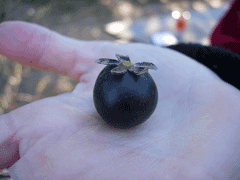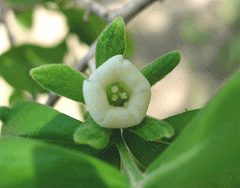 |
|
http://flickr.com/photos/74215305%40N00 |
 |
| http://flickr.com/photos/74215305%40N00 |
Translate this page:
Summary
Physical Characteristics

 Diospyros texanum is a TREE growing to 12 m (39ft 4in). The species is hermaphrodite (has both male and female organs).
Diospyros texanum is a TREE growing to 12 m (39ft 4in). The species is hermaphrodite (has both male and female organs).
Suitable for: light (sandy), medium (loamy) and heavy (clay) soils. Suitable pH: mildly acid, neutral and basic (mildly alkaline) soils. It can grow in semi-shade (light woodland) or no shade. It prefers moist soil.
UK Hardiness Map
US Hardiness Map
Synonyms
Brayodendron texanum
Plant Habitats
Woodland Garden Secondary; Sunny Edge;
Edible Uses
Fruit - raw. The fruits, which are about 20mm in diameter are sweet and tasty when fully ripe[149, 274].
References More on Edible Uses
Medicinal Uses
Plants For A Future can not take any responsibility for any adverse effects from the use of plants. Always seek advice from a professional before using a plant medicinally.
None known
References More on Medicinal Uses
The Bookshop: Edible Plant Books
Our Latest books on Perennial Plants For Food Forests and Permaculture Gardens in paperback or digital formats.

Edible Tropical Plants
Food Forest Plants for Hotter Conditions: 250+ Plants For Tropical Food Forests & Permaculture Gardens.
More

Edible Temperate Plants
Plants for Your Food Forest: 500 Plants for Temperate Food Forests & Permaculture Gardens.
More

More Books
PFAF have eight books available in paperback and digital formats. Browse the shop for more information.
Shop Now
Other Uses
A black dye can be obtained from the juice of the fruit[149, 274]. Wood - heavy, hard, compact, takes a high polish[149]. It is used for making tools, engraving blocks etc[149].
Special Uses
References More on Other Uses
Cultivation details
References Carbon Farming Information and Carbon Sequestration Information
Temperature Converter
Type a value in the Celsius field to convert the value to Fahrenheit:
Fahrenheit:
The PFAF Bookshop
Plants For A Future have a number of books available in paperback and digital form. Book titles include Edible Plants, Edible Perennials, Edible Trees,Edible Shrubs, Woodland Gardening, and Temperate Food Forest Plants. Our new book is Food Forest Plants For Hotter Conditions (Tropical and Sub-Tropical).
Shop Now
Plant Propagation
Seed - best sown in a cold frame as soon as it is ripe[113, 200]. Stored seed requires a period of cold-stratification and should be sown as early in the year as possible[78]. It usually germinates in 1 - 6 months at 15°c[175]. Pot up the young seedlings as soon as they are large enough to handle into fairly deep pots and plant them out into their permanent positions in early summer. Give them some protection from winter cold for their first year or two outdoors. Cuttings of half-ripe wood, July/August in a frame[200]. Layering in spring[200].
Other Names
If available other names are mentioned here
Native Range
Coming Soon
Weed Potential
Right plant wrong place. We are currently updating this section.
Please note that a plant may be invasive in one area but may not in your area so it's worth checking.
Conservation Status
IUCN Red List of Threatened Plants Status :

| Related Plants
|
| Latin Name | Common Name | Habit | Height | Hardiness | Growth | Soil | Shade | Moisture | Edible | Medicinal | Other |
| Diospyros celebica | Indonesian Ebony, black ebony, makassar-ebenholts | Tree | 30.0 |
10-12
| S | LMH | N | M | 2 | 0 | 4 |
| Diospyros conzattii | Zapote negro mont's, zapotillo. | Tree | 10.0 |
10-12
| S | LMH | N | DM | 4 | 0 | 2 |
| Diospyros crassiflora | Benin Ebony | Tree | 15.0 |
10-12
| S | LMH | N | M | 0 | 2 | 4 |
| Diospyros digyna | Black Sapote, Chocolate Pudding Tree | Tree | 15.0 |
10-12
| S | LMH | SN | M | 4 | 1 | 2 |
| Diospyros ebenum | Ebony, Ceylon Ebony, Mauritius Ebony, Ebony Persimmon | Tree | 20.0 |
10-12
| S | LMH | N | M | 1 | 2 | 4 |
| Diospyros kaki | Persimmon, Japanese persimmon | Tree | 12.0 |
7-10
| M | LMH | SN | M | 4 | 3 | 3 |
| Diospyros lotus | Date Plum | Tree | 9.0 |
7-9
| M | LMH | SN | M | 5 | 1 | 3 |
| Diospyros malabarica | Indian Persimmon, Gaub, Timbiri, Mountain ebony | Tree | 35.0 |
10-12
| S | LMH | FSN | M | 1 | 3 | 4 |
| Diospyros mespiliformis | West African Ebony, Monkey guava, jackalberry | Tree | 20.0 |
10-12
| M | LMH | N | M | 4 | 3 | 4 |
| Diospyros mun | Mun Ebony, Vietnamese Ebony | Tree | 15.0 |
10-12
| S | LMH | N | DM | 0 | 0 | 4 |
| Diospyros quaesita | Calamander, kalu mediriya | Tree | 30.0 |
10-12
| S | LMH | N | DM | 0 | 2 | 4 |
| Diospyros tessellaria | Black ebony, Mauritian ebony | Tree | 15.0 |
10-12
| S | LMH | N | M | 2 | 0 | 4 |
| Diospyros virginiana | American Persimmon, Common persimmon, Persimmon | Tree | 20.0 |
4-8
| M | LMH | SN | M | 5 | 1 | 3 |
|
Growth: S = slow M = medium F = fast. Soil: L = light (sandy) M = medium H = heavy (clay). pH: A = acid N = neutral B = basic (alkaline). Shade: F = full shade S = semi-shade N = no shade. Moisture: D = dry M = Moist We = wet Wa = water.
Now available:
Food Forest Plants for Mediterranean Conditions
350+ Perennial Plants For Mediterranean and Drier Food Forests and Permaculture Gardens.
[Paperback and eBook]
This is the third in Plants For A Future's series of plant guides for food forests tailored to
specific climate zones. Following volumes on temperate and tropical ecosystems, this book focuses
on species suited to Mediterranean conditions—regions with hot, dry summers and cool, wet winters,
often facing the added challenge of climate change.
Read More
Expert comment
Author
Scheele.
Botanical References
274
Links / References
For a list of references used on this page please go here
Readers comment
| Add a comment |
|
If you have important information about this plant that may help other users please add a comment or link below. Only comments or links that are felt to be directly relevant to a plant will be included. If you think a comment/link or information contained on this page is inaccurate or misleading we would welcome your feedback at [email protected]. If you have questions about a plant please use the Forum on this website as we do not have the resources to answer questions ourselves.
* Please note: the comments by website users are not necessarily those held by PFAF and may give misleading or inaccurate information.
To leave a comment please Register or login here All comments need to be approved so will not appear immediately.
|
Subject : Diospyros texanum
|
|
|
|